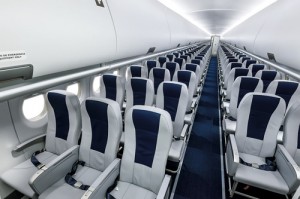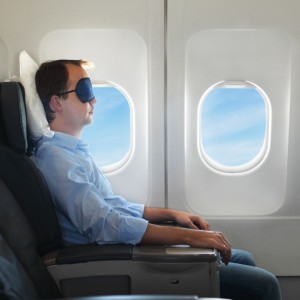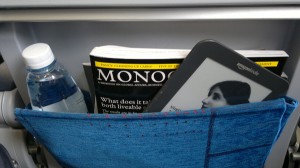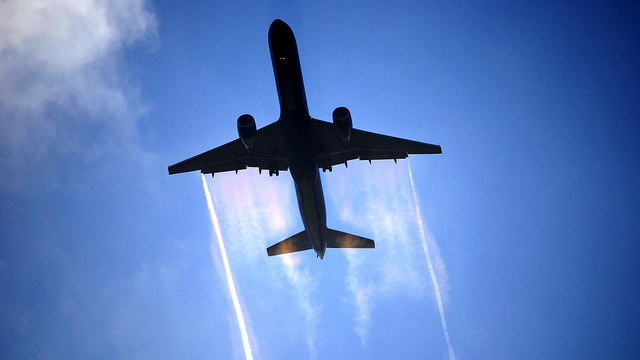We’ve all heard the facts: statistically speaking, flying is far safer than driving. Not only are airplanes continuously getting safer, but everyday activities from walking to driving are still considerably more dangerous than flying. In fact, according to the New York Times, a traveler could fly every day for 123,000 years and still be safe! Rationally speaking, that doesn’t sound so bad … right? Well, not necessarily, huh? Fears aren’t always rooted in rationality — and that’s okay, we’re here to help! Read on for some quick and easy techniques for easing your fear of flying (no pills required!):
1. Choose the right seat: When turbulence hits, the front is usually less bumpy than the back,  and you also won’t be looking down the length of the plane bouncing around in front of you. Now the bigger question: aisle or window? This is personal preference, but if heights make you anxious (and you’re not claustrophobic), opt for an aisle. On the other hand, you may actually prefer the window so you can look at the spectacular views—what a great distraction! Most airlines and booking engines allow you to choose your seat when you book your flight (with the exception of airlines like Southwest), so book early and you won’t be disappointed.
and you also won’t be looking down the length of the plane bouncing around in front of you. Now the bigger question: aisle or window? This is personal preference, but if heights make you anxious (and you’re not claustrophobic), opt for an aisle. On the other hand, you may actually prefer the window so you can look at the spectacular views—what a great distraction! Most airlines and booking engines allow you to choose your seat when you book your flight (with the exception of airlines like Southwest), so book early and you won’t be disappointed.
2. Upgrade (if you can): Let’s not sugar coat this…we all know that advancing through the cabin ranks will make for a much more positive flight experience. After all, the more comfortable you are, the easier it is to relax. If upgrading isn’t an option, use SeatGuru to find the best coach seat – this handy website lists color-coded seating charts for hundreds of aircraft! Also, make it a point to check in 24 hours before departure as many airlines open up their premium seating options, like the bulkhead, for purchase during this time.
Extra Credit: Consider “outing” your fears to the flight attendants. Airlines are very good at reassuring — and accommodating — anxious passengers.
3. Get some sleep: Hey, if you can put yourself out of your misery, even better, right? Neck  pillows, eye masks, earplugs, noise-cancelling headphones, some tunes from Enya — anything you need to make sleep happen, bring it on. For those planning to use a sleep aid, such as Melatonin, talk to your doctor before you do. Once you get the green light, it also couldn’t hurt to test it out at home to avoid potential adverse reactions while you’re in the air. If turbulence is preventing your slumber, remember that turbulence is the flight equivalent of a bumpy road. It won’t last forever and is par for the course. In fact, even when you feel like the plane is dropping thousands of feet, it’s really only moving a fraction of an inch. How can this be? Well, the best analogy is speed bumps — hit one at 10 mph and you barely feel it, but hit one at 500 mph and that’s one rough ride! Feeling better? We sure are!
pillows, eye masks, earplugs, noise-cancelling headphones, some tunes from Enya — anything you need to make sleep happen, bring it on. For those planning to use a sleep aid, such as Melatonin, talk to your doctor before you do. Once you get the green light, it also couldn’t hurt to test it out at home to avoid potential adverse reactions while you’re in the air. If turbulence is preventing your slumber, remember that turbulence is the flight equivalent of a bumpy road. It won’t last forever and is par for the course. In fact, even when you feel like the plane is dropping thousands of feet, it’s really only moving a fraction of an inch. How can this be? Well, the best analogy is speed bumps — hit one at 10 mph and you barely feel it, but hit one at 500 mph and that’s one rough ride! Feeling better? We sure are!
4. Just Breathe: One basic calming technique recommended by doctors is conscious, deep breathing: in through your nose and out through your mouth as slowly as possible. It may seem obvious, but it works! Breathing also helps prevent (or stop) panic attacks. Try to maintain a relaxed posture without clinging to the chair’s armrests, since this can heighten anxiety. Having trouble focusing? Well, there’s an app for that! That’s right, there are actually apps to help you with your breathing and keep your focus. A few to try: Breathe2Relax, and the Mayo Clinic Anxiety Coach App.
5. Get Distracted: Think about the length of your flight and what you can do to keep yourself busy, whether it’s watching a movie, listening to music, reading a book or doing puzzles. Pack your distractions in your carry-on and keep them close by. For inspiration, check out 10 Things You Can Do to Keep Yourself Busy on an Airplane.
6. Try Alternative Remedies: Some nervous fliers swear by sipping on decaffeinated herbal teas  like chamomile, sniffing on lavender and/or even sucking on peppermints — all of which work well for calming the senses. Ditch the coffee and soda (the last thing you need is a stimulant!) and when it comes to alcoholic beverages, think before you drink. Contrary to popular belief, alcohol can actually heighten your anxiety, so use your best judgment.
like chamomile, sniffing on lavender and/or even sucking on peppermints — all of which work well for calming the senses. Ditch the coffee and soda (the last thing you need is a stimulant!) and when it comes to alcoholic beverages, think before you drink. Contrary to popular belief, alcohol can actually heighten your anxiety, so use your best judgment.
7. Have a Last Resort: Some doctors prescribe anxious fliers with fast-acting anxiety medications like Xanax or Valium, but these can have their own unpleasant side effects. The solution? Bring them along, but take them if (and only if!) you need them. One caveat: your prescription may actually be considered illegal in some countries. Play it safe and check before you go. On Call members can call us, but everyone else can check with your country’s local embassy. If you don’t have a prescription, herbal remedies like St. John’s Wort may help calm nerves too, but talk to your doctor first. St. John’s Wort is not approved by FDA and should only be purchased from a reliable source.
Got any other tried and true tips for reducing in-flight anxiety? Let us know!
Safe Travels!
Plane in flight from Bill Abbott
Airplane seats from SuperJet International
In-flight entertainment from Mikael Leppä



